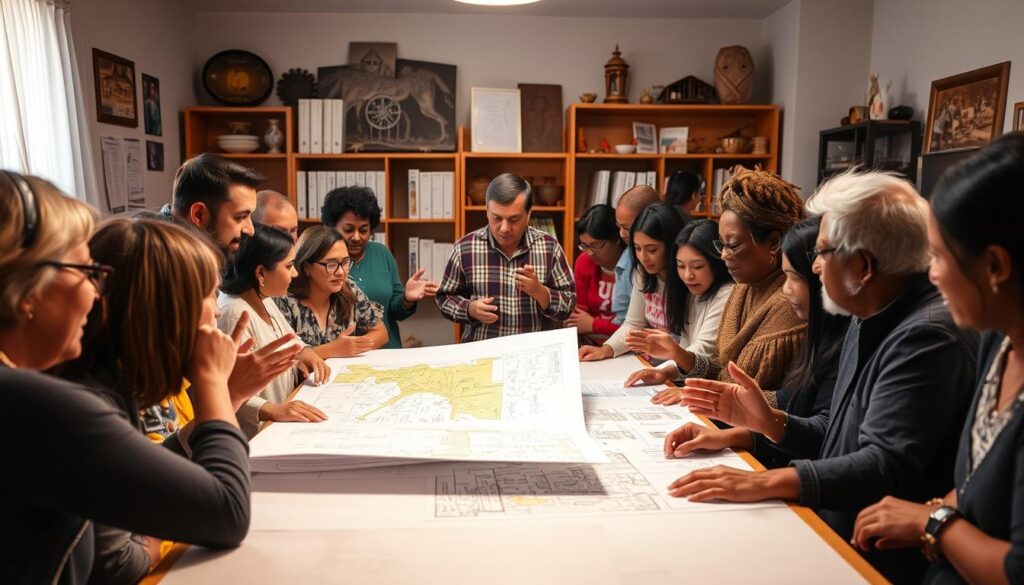Did you know that effective infrastructure development process relies heavily on the active participation of local communities? Communities are the heart of local development, and their impact is often top of mind for local leaders as they identify and propose projects to address infrastructure needs and climate concerns.
When communities are engaged in the planning process, it leads to more effective and sustainable solutions. This is because stakeholder participation ensures that the needs and concerns of the local population are taken into account, resulting in infrastructure projects that truly benefit the community.
Key Takeaways
- Effective infrastructure planning relies on community participation.
- Community-driven projects lead to more sustainable solutions.
- Stakeholder participation is crucial for successful infrastructure development.
- Local communities play a vital role in shaping infrastructure projects.
- Engaging communities in planning ensures that projects meet local needs.
Understanding Community Engagement
Effective community engagement is crucial for fostering trust and support among constituents for infrastructure initiatives. By actively involving the community in the planning process, projects can better meet the needs and expectations of the public, leading to more successful outcomes.
What is Community Engagement?
Community engagement refers to the process of working collaboratively with community groups to address issues that impact their well-being. It involves public input in urban planning and citizen involvement in infrastructure projects, ensuring that the voices of all stakeholders are heard.
This collaborative approach helps in making informed decisions that reflect the needs and aspirations of the community. Through participatory decision-making, community members are empowered to contribute to the planning and development of infrastructure projects.
Importance of Community Input
Community input is vital as it provides valuable insights into the needs and concerns of the community. It helps in identifying potential issues early on, thereby reducing the risk of project delays or failures due to lack of community support.
- Enhances project relevance by aligning it with community needs.
- Fosters trust and transparency between the community and project developers.
- Encourages community support and participation in project implementation.
As noted by a community development expert, “Community engagement is not just about informing the public; it’s about involving them in the decision-making process to create a sense of ownership and responsibility.”
“Community engagement is the backbone of successful infrastructure projects. It ensures that projects are tailored to meet the specific needs of the community, thereby enhancing their sustainability and impact.”
Historical Context of Engagement
The concept of community engagement has evolved over time, from a top-down approach to a more inclusive and participatory model. Historically, infrastructure projects were often planned and executed without significant input from the communities they affected.
However, the importance of citizen involvement in infrastructure projects has become increasingly recognized, leading to the adoption of more collaborative and inclusive planning processes.
| Aspect | Traditional Approach | Modern Approach |
|---|---|---|
| Community Involvement | Limited or no involvement | Active participation and engagement |
| Decision-Making | Top-down | Participatory and inclusive |
Benefits of Community Involvement

By involving the community in infrastructure planning, projects become more sustainable and effective. This collaborative approach ensures that the needs and concerns of the community are addressed, leading to better outcomes.
Building Trust and Transparency
Community involvement helps build trust between the community and the project developers. Transparent communication is key to this process, ensuring that all stakeholders are informed and engaged throughout the project lifecycle.
For instance, a study on community engagement in infrastructure projects found that transparent communication can increase community trust by up to 70%. This is crucial for the success of infrastructure projects, as it fosters a sense of ownership among community members.
Enhancing Project Relevance
When communities are involved in the planning process, the resulting projects are more likely to meet their actual needs. This is because community members provide valuable insights into the local context, helping to tailor the project to the specific requirements of the area.
For example, a community outreach program in a local development project identified the need for improved public transportation. As a result, the project was adjusted to include a new bus route, significantly enhancing the quality of life for residents.
Fostering Local Expertise
Community involvement also fosters local expertise, as community members bring their knowledge and experience to the table. This local insight is invaluable in shaping infrastructure projects that are not only effective but also sustainable in the long term.
Data from various community-driven infrastructure projects show that involving local experts can improve project outcomes by up to 40%. This is because local experts understand the unique challenges and opportunities of the area.
| Benefits | Description | Impact |
|---|---|---|
| Building Trust | Transparent communication and community engagement | Increased community trust by up to 70% |
| Enhancing Project Relevance | Community insights into local needs | Better project outcomes meeting community needs |
| Fostering Local Expertise | Involvement of local experts in project planning | Improved project outcomes by up to 40% |
By working together to understand the needs of residents and inform policymakers, organizations are helping to ensure that similar areas around the country receive long-awaited attention and investments.
Key Strategies for Engagement
Infrastructure projects benefit significantly from robust community engagement strategies. Engaging the community effectively is crucial for the success and sustainability of infrastructure development projects.
Effective Communication Methods
Clear and transparent communication is the backbone of successful community engagement. It’s essential to use multiple channels to reach different segments of the community, including social media, local newspapers, and community boards.
- Use simple, jargon-free language to explain complex infrastructure concepts.
- Provide regular updates on project progress and timelines.
- Encourage two-way communication by inviting feedback and questions.
Utilizing Technology and Social Media
Technology and social media play a vital role in modern community engagement. They offer innovative ways to reach a wider audience and facilitate participation in the infrastructure development process.
Local leaders can leverage tools like the Investing in High-Quality Infrastructure Jobs Toolkit to guide them through securing and deploying funding for workforce development. This not only enhances stakeholder participation but also ensures equitable access to good jobs.
- Utilize online platforms for surveys and feedback collection.
- Create dedicated project websites for information dissemination.
- Engage with the community through social media platforms.
Workshops and Public Meetings
Workshops and public meetings are traditional yet effective methods for community engagement in infrastructure planning. They provide a platform for direct interaction between project stakeholders and the community.
To maximize their effectiveness, it’s crucial to:
- Choose accessible venues.
- Provide materials in multiple languages if necessary.
- Ensure that meetings are well-publicized and scheduled at convenient times.
By combining these strategies, infrastructure projects can foster a more inclusive and participatory planning process, ultimately leading to more successful and sustainable outcomes.
Identifying Stakeholders

Identifying the right stakeholders is crucial for successful community engagement in infrastructure projects. Stakeholders can significantly influence the outcome of a project, and their early involvement can help identify potential issues and opportunities.
Who Should be Involved?
A wide range of stakeholders should be considered for involvement in infrastructure planning. This includes local residents, business owners, community groups, and government agencies. Public input in urban planning is essential to ensure that projects meet the needs and expectations of the community.
Cities should work closely with workforce development experts, such as local workforce boards, unions, and community colleges, to leverage existing programs and processes for community-driven workforce development. As noted by a workforce development expert, “Collaboration between infrastructure planners and workforce development agencies is key to creating projects that benefit both the community and the economy.”
“The most successful infrastructure projects are those that have been shaped by the people they serve.”
Approaches to Stakeholder Mapping
Stakeholder mapping is a systematic process used to identify and analyze stakeholders. It involves categorizing stakeholders based on their level of interest and influence over the project. Effective stakeholder mapping enables planners to develop targeted engagement strategies.
| Stakeholder Group | Interest Level | Influence Level |
|---|---|---|
| Local Residents | High | Medium |
| Business Owners | High | High |
| Community Groups | Medium | Medium |
Engaging Underserved Communities
Engaging underserved communities is critical for ensuring that infrastructure projects are equitable and beneficial to all members of the community. This involves using participatory decision-making processes that empower these communities to have a voice in the planning process.
Citizen involvement in infrastructure projects not only enhances the quality of the projects but also fosters a sense of community ownership. By engaging diverse stakeholders, including underserved communities, planners can create more inclusive and sustainable infrastructure.
Techniques for Feedback Collection
Collecting feedback from the community is a vital component of inclusive and responsive infrastructure planning. It allows project developers to understand the needs and concerns of the public, making it possible to tailor projects to better serve the community.
Surveys and Questionnaires
Surveys and questionnaires are widely used tools for gathering feedback from a large number of people. They can be distributed online or offline, depending on the target audience and the resources available. Well-designed surveys can provide valuable insights into community preferences and opinions.
For instance, online surveys can be shared through social media and email newsletters, making it easy to reach a wide audience. Offline surveys can be distributed in public spaces, such as community centers or libraries, to capture feedback from those who may not be as active online.
Focus Groups and Interviews
Focus groups and interviews offer a more in-depth approach to gathering feedback. They involve direct interaction with community members, allowing for detailed discussions and the collection of nuanced feedback.
Focus groups bring together a diverse group of community members to discuss specific topics related to the infrastructure project. Interviews, on the other hand, provide an opportunity for one-on-one interactions, which can be particularly useful for understanding the perspectives of individuals who may not feel comfortable sharing their views in a group setting.
Interactive Platforms and Apps
Interactive platforms and apps represent a modern and engaging way to collect community feedback. These tools can make the feedback process more accessible and enjoyable for participants. For example, mobile apps can be used to collect feedback on specific aspects of infrastructure projects, such as design or functionality.
Some cities have successfully utilized online platforms to engage with citizens and gather feedback on urban development projects. For more information on how technology is enhancing community engagement in infrastructure projects, visit this blog post on community engagement in infrastructure projects.
Overcoming Barriers to Engagement

Overcoming barriers to community engagement is essential for fostering stakeholder participation in the infrastructure development process. Effective engagement strategies can help build trust and ensure that all voices are heard.
Addressing Apathy and Distrust
Community apathy and distrust are significant barriers to engagement. To address these issues, it’s crucial to establish transparent communication channels and demonstrate the value of community input. Building trust takes time and consistent effort.
One approach is to engage community members in the decision-making process through inclusive planning initiatives. This not only empowers the community but also fosters a sense of ownership.
Language and Cultural Considerations
Language and cultural differences can also hinder effective community engagement. It’s essential to develop multilingual engagement strategies and culturally sensitive materials to ensure inclusivity.
For instance, providing translated materials and interpreters at public meetings can help ensure that all community members can participate fully.
| Strategy | Description | Benefit |
|---|---|---|
| Multilingual Materials | Providing information in multiple languages | Increased accessibility for diverse communities |
| Cultural Sensitivity Training | Training staff on cultural nuances | Enhanced understanding and respect for community values |
| Inclusive Public Meetings | Ensuring all voices are heard at meetings | Fosters a sense of community and shared decision-making |
Time and Accessibility Issues
Time constraints and accessibility issues are other barriers that can limit community engagement. Flexible meeting times and accessible venues can help mitigate these challenges.
Utilizing technology, such as virtual meetings and online engagement platforms, can also expand participation opportunities.
By understanding and addressing these barriers, communities can foster a more inclusive and participatory infrastructure development process.
The Role of Government Agencies
Government agencies are crucial in facilitating public input in urban planning and infrastructure development. Their role is multifaceted, involving the facilitation of participation, collaboration with local organizations, and the establishment of policy frameworks that support community engagement.
Facilitating Participation
Government agencies can facilitate participation by providing resources and support for community engagement initiatives. This includes funding for community outreach and education programs, which are essential for informing the public about infrastructure projects and gathering their feedback.
For instance, government agencies can organize public meetings and workshops where community members can share their views on proposed infrastructure projects. These events not only provide a platform for public input but also help in building trust between the community and government agencies.
Collaboration with Local Organizations
Collaboration with local organizations is another critical aspect of government agencies’ role in community engagement. By partnering with local groups, government agencies can leverage their knowledge of the community’s needs and preferences, thereby enhancing the effectiveness of engagement initiatives.
Local organizations can also help in disseminating information about infrastructure projects to the community, thereby increasing public awareness and participation. For more information on engaging the community for infrastructure and climate projects, visit https://localinfrastructure.org/resources/engaging-the-community-for-infrastructure-and-climate-projects/.
Policy Frameworks Supporting Engagement
Government agencies play a vital role in establishing policy frameworks that support community engagement. These frameworks provide the necessary guidelines and regulations that ensure public input is considered in infrastructure planning and decision-making processes.
Effective policy frameworks can include provisions for public hearings, comment periods, and the use of technology to facilitate citizen involvement in infrastructure projects. By having such frameworks in place, government agencies can ensure that community engagement is not only encouraged but also integrated into the fabric of infrastructure planning.
| Role of Government Agencies | Description | Benefits |
|---|---|---|
| Facilitating Participation | Providing resources and support for community engagement initiatives | Increased public awareness and participation |
| Collaboration with Local Organizations | Partnering with local groups to leverage their knowledge and reach | Enhanced effectiveness of engagement initiatives |
| Policy Frameworks | Establishing guidelines and regulations for public input in infrastructure planning | Ensures public input is considered in decision-making |
Case Studies in Community Engagement

In recent years, community engagement has emerged as a critical factor in shaping infrastructure projects. The Community Connectors grant program is a prime example, supporting government and community collaborations in small and mid-sized U.S. cities to advance locally driven projects that reconnect communities separated or harmed by transportation infrastructure.
Successful Examples Across the U.S.
Several cities have successfully integrated community feedback into their infrastructure development plans. For instance, a city might use public consultation to inform the design of a new public transportation system, ensuring it meets the community’s needs. Case studies have shown that such approaches not only enhance project relevance but also foster a sense of community ownership.
Lessons Learned from Past Projects
Past projects have taught valuable lessons about the importance of community outreach in planning initiatives. Effective engagement requires early and continuous involvement of the community, using a variety of methods to capture diverse perspectives. This includes leveraging technology, such as interactive platforms and apps, to facilitate broader participation.
Impact on Community Development
The impact of community engagement on development is multifaceted. It not only ensures that infrastructure projects are aligned with community needs but also contributes to community development by fostering trust and promoting local expertise. As a result, communities are more likely to support and benefit from infrastructure projects.
By examining these case studies, it becomes clear that community feedback in city development is not just beneficial but essential for creating infrastructure that truly serves the community’s needs.
Evaluating Engagement Efforts
Evaluating community engagement efforts is crucial for understanding the effectiveness of initiatives aimed at fostering stakeholder participation in the infrastructure development process. By assessing these efforts, planners can identify areas of improvement and adapt strategies to better meet community needs.
Metrics for Success
To evaluate the success of community engagement initiatives, it’s essential to establish clear metrics. These can include:
- Participation rates in public meetings and surveys
- Quality of feedback received from the community
- Level of community satisfaction as measured through surveys or focus groups
By tracking these metrics, planners can gain insights into the effectiveness of their engagement strategies and make informed decisions about future initiatives.
Continuous Improvement Processes
Continuous improvement is key to successful community engagement. This involves regularly reviewing engagement strategies, soliciting feedback from the community, and being willing to adapt approaches as needed. For more information on innovative approaches to community engagement, visit World Civil Society.
Adapting Strategies Based on Feedback
Adapting engagement strategies based on community feedback is vital for ensuring that initiatives remain relevant and effective. This can involve:
- Analyzing feedback to identify common themes and concerns
- Adjusting communication channels to better reach the community
- Incorporating community suggestions into project planning
By embracing a flexible and responsive approach to community engagement, planners can foster a more collaborative and inclusive infrastructure development process.
The Future of Community Engagement

The landscape of community engagement is evolving, driven by technological advancements and shifting societal needs. As we move forward, it’s essential to understand the trends that will shape the future of public input in urban planning and citizen involvement in infrastructure projects.
Trends in Infrastructure Planning
Infrastructure planning is becoming more sophisticated, incorporating data analytics and virtual reality to better engage communities. These technologies enable more effective participatory decision-making by providing stakeholders with immersive experiences and data-driven insights.
The use of digital platforms is also on the rise, allowing for broader and more inclusive community engagement. These platforms facilitate the collection of feedback and foster a sense of ownership among community members.
The Role of Artificial Intelligence
Artificial intelligence (AI) is poised to revolutionize community engagement by analyzing large datasets to identify patterns and preferences. AI can help tailor engagement strategies to specific community needs, enhancing the effectiveness of citizen involvement in infrastructure projects.
AI-powered tools can also automate routine tasks, freeing up resources for more nuanced and human-centered engagement activities. This blend of technology and human insight is likely to become a hallmark of future community engagement initiatives.
Social Equity in Planning Initiatives
As community engagement continues to evolve, there is a growing emphasis on social equity in planning initiatives. This involves ensuring that all segments of the community have a voice in the planning process, particularly those that have been historically marginalized or underrepresented.
Efforts to promote social equity include targeted outreach programs and the use of inclusive language in engagement materials. By prioritizing equity, planners can create more just and sustainable infrastructure that serves the needs of the entire community.
The future of community engagement is bright, with numerous opportunities to enhance participatory decision-making and foster more inclusive and equitable infrastructure planning. As we continue to innovate and adapt, it’s crucial to remain focused on the core principles of community engagement: transparency, inclusivity, and responsiveness to community needs.
The Power of Visual Communication
Visual storytelling is emerging as a key strategy in enhancing community feedback and participation in city development projects. By leveraging visual elements, planners can convey complex information in an accessible and engaging manner, fostering a more inclusive and effective community engagement process.
Using Maps and Diagrams
Maps and diagrams are invaluable tools in visual communication, allowing community members to visualize infrastructure projects and provide informed feedback. These visual aids can simplify complex concepts, making it easier for the public to understand and engage with the planning process.
Key benefits of using maps and diagrams include:
- Enhanced clarity in project presentation
- Increased community engagement through interactive elements
- Better-informed feedback due to clearer understanding of project details
Infographics for Clarity
Infographics are another powerful tool for visual communication, capable of distilling complex data into easily digestible formats. By presenting information in a visually appealing way, infographics can facilitate public consultation for infrastructure projects, making it easier for community members to grasp key information and provide meaningful feedback.
The use of infographics can significantly enhance the clarity of project information, leading to more effective community outreach in planning initiatives.
Engaging Visual Storytelling
Engaging visual storytelling involves using narrative techniques alongside visual elements to convey the vision and impact of infrastructure projects. This approach can captivate community members, encouraging active participation in the planning process and fostering a sense of community ownership.
By combining compelling narratives with visual aids, planners can create an engaging and inclusive community engagement process that resonates with a diverse audience.
Engaging Youth and Schools

Engaging the younger generation in infrastructure planning is vital for the future of our communities. By involving youth in the decision-making process, we can foster a culture of community engagement and ensure that future generations are equipped to manage and develop infrastructure effectively.
Importance of Educating Future Generations
Educating young people about infrastructure planning is crucial for several reasons. Firstly, it helps them understand the complexities of infrastructure development and its impact on communities. Secondly, it encourages them to participate in the planning process, thereby fostering a sense of ownership and responsibility. This early engagement can lead to more sustainable and community-centric infrastructure projects.
Moreover, involving youth in infrastructure planning can have long-term benefits. It can inspire the next generation of urban planners, engineers, and policymakers, ensuring that they are well-equipped to address future infrastructure challenges.
Partnerships with Educational Institutions
One effective way to engage youth is through partnerships with educational institutions. Schools and universities can play a pivotal role in integrating infrastructure planning into their curricula, thereby educating students about its importance and relevance.
For instance, educational institutions can collaborate with local government agencies to develop project-based learning programs focused on infrastructure development. This not only enhances students’ understanding of the subject but also provides them with practical experience.
| Benefits | Description |
|---|---|
| Enhanced Understanding | Students gain a deeper understanding of infrastructure planning and its complexities. |
| Practical Experience | Project-based learning provides students with hands-on experience in infrastructure development. |
| Increased Engagement | Youth are more likely to participate in community planning processes. |
Youth-led Initiatives in Planning
Youth-led initiatives can also play a significant role in infrastructure planning. By empowering young people to lead projects or contribute to planning committees, we can tap into their creativity and innovative thinking.
For example, some cities have established youth councils that focus on infrastructure and urban planning. These councils provide a platform for young people to voice their ideas and concerns, ensuring that their perspectives are considered in the planning process.
By engaging youth and schools in infrastructure planning, we can create a more inclusive and forward-thinking approach to community development. This not only benefits the young people involved but also enriches the community as a whole.
Funding Community Engagement Initiatives
Funding community engagement initiatives is a multifaceted process that involves budgeting, seeking grants, and implementing cost-effective strategies. Effective citizen involvement in infrastructure projects requires a well-planned financial approach to ensure that community engagement is both meaningful and sustainable.
Budgeting for Engagement
Allocating a specific budget for community engagement is crucial. This involves identifying the costs associated with different engagement strategies, such as public meetings, surveys, and digital platforms. A well-planned budget ensures that resources are utilized efficiently to facilitate participatory decision-making.
| Engagement Activity | Estimated Cost | Potential Impact |
|---|---|---|
| Public Meetings | $5,000 | High community visibility |
| Online Surveys | $2,000 | Broad reach, easy to analyze |
| Workshops | $8,000 | In-depth community input |
Grant Opportunities and Support
Exploring grant opportunities is a vital step in funding community engagement initiatives. Various government and private organizations offer grants to support community development projects. For instance, community engagement helps drive much-needed infrastructure, as highlighted by recent research.
- Government Grants: Federal and state agencies often provide funding for community engagement as part of larger infrastructure projects.
- Private Foundations: Many private foundations support community development initiatives, including those focused on citizen involvement.
- Corporate Sponsorships: Local businesses may also be willing to sponsor community engagement activities.
Cost-Effective Engagement Strategies
Implementing cost-effective engagement strategies is essential to maximize the impact of limited budgets. Utilizing digital tools, such as social media and online forums, can be a cost-efficient way to engage a large number of community members. Additionally, partnering with local organizations can help amplify the reach and effectiveness of engagement efforts.
By adopting a combination of budgeting, seeking grants, and implementing cost-effective strategies, community engagement initiatives can be funded effectively, ensuring that public input in urban planning is both meaningful and impactful.
Integrating Cultural Perspectives

Effective community outreach in planning initiatives requires a deep understanding of the cultural fabric of the community. By integrating cultural perspectives, we can ensure that community engagement is not only inclusive but also meaningful to all participants.
Respecting Local Traditions and Values
Respecting local traditions and values is fundamental to successful community engagement. This involves understanding the historical and cultural context of the community and incorporating this understanding into the engagement process. For instance, community feedback in city development projects can be significantly enhanced by acknowledging and respecting local customs and practices.
By doing so, we can foster a sense of trust and cooperation among community members, which is essential for the success of infrastructure projects. This approach also ensures that public consultation for infrastructure projects is conducted in a manner that is sensitive to the needs and values of the community.
Multilingual Engagement Strategies
To ensure inclusivity, it’s crucial to implement multilingual engagement strategies. This can involve providing information and engagement opportunities in multiple languages, thereby ensuring that all community members can participate fully. Such strategies are particularly important in diverse communities where language barriers might otherwise hinder effective community outreach in planning initiatives.
Utilizing multiple languages in engagement efforts not only enhances participation but also demonstrates a commitment to respecting and valuing the diversity of the community.
Celebrating Community Identity
Celebrating community identity is an integral part of integrating cultural perspectives into community engagement. By acknowledging and celebrating the unique characteristics and strengths of the community, we can foster a sense of pride and ownership among community members.
This can be achieved through various means, such as incorporating local art, history, and cultural practices into engagement initiatives. By doing so, we can create a more engaging and meaningful experience for community members, thereby enhancing the overall effectiveness of community feedback in city development projects.
The Impact of Public Opinion
The impact of public opinion on infrastructure projects cannot be overstated, as it plays a crucial role in determining their success or failure. Public opinion can significantly influence the trajectory of infrastructure development, from initial planning stages to final implementation.
The Role of Media in Shaping Perspectives
The media plays a pivotal role in shaping public opinion regarding infrastructure projects. Through various channels, including news articles, social media, and documentaries, the media can influence how the public perceives these projects. Effective stakeholder participation involves understanding and engaging with the media to ensure a balanced representation of the project’s goals and benefits.
By fostering a positive relationship with media outlets, project managers can help ensure that the public is well-informed about the project’s objectives, timelines, and potential impacts. This can be achieved through regular updates, press releases, and interviews with key project personnel.
Tracking Community Sentiment
Tracking community sentiment is essential for understanding public opinion and identifying areas of concern. This can be done through various methods, including surveys, public meetings, and social media monitoring. By staying attuned to community sentiment, project managers can respond proactively to concerns and adjust their strategies as needed.
Utilizing tools and techniques for sentiment analysis can provide valuable insights into public opinion, helping to identify trends and patterns that may inform project decisions. For more information on managing infrastructure projects, visit this resource on civil engineering in project management.
Responding to Public Concerns
Responding effectively to public concerns is critical for maintaining positive community relations and ensuring the successful implementation of infrastructure projects. This involves addressing concerns in a timely and transparent manner, providing clear information about the project’s benefits and mitigations.
By engaging with the community and responding to their concerns, project managers can build trust and foster a collaborative environment. This not only enhances the project’s reputation but also contributes to its long-term success.
Celebrating Community Successes
Celebrating community successes is essential for fostering a culture of community engagement and participatory decision-making. By highlighting achievements and recognizing the contributions of community members, we can build momentum for future infrastructure projects that incorporate public input in urban planning and encourage citizen involvement in infrastructure projects.
Achievements and Contributions
Recognizing the efforts of community members who participate in community engagement initiatives is crucial for sustaining momentum. This can be achieved through various means, such as community events, social media campaigns, or local newsletters.
Building Momentum
By celebrating community successes, we can create a positive feedback loop that encourages further community involvement. This, in turn, can lead to more effective and sustainable infrastructure projects that reflect the needs and aspirations of the community.
